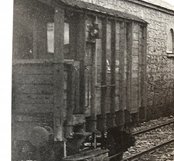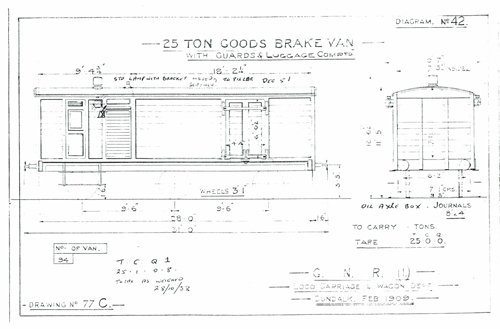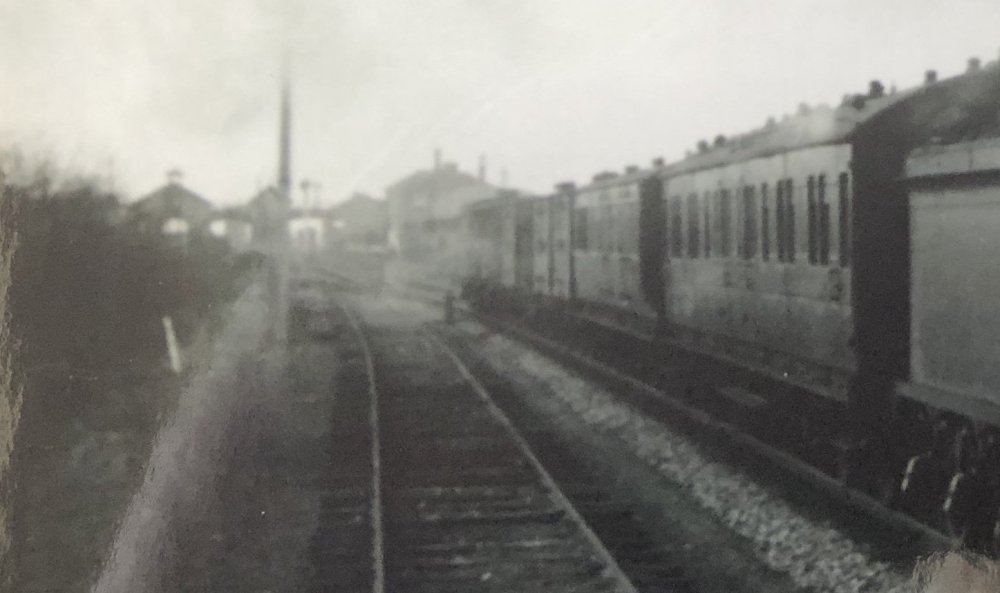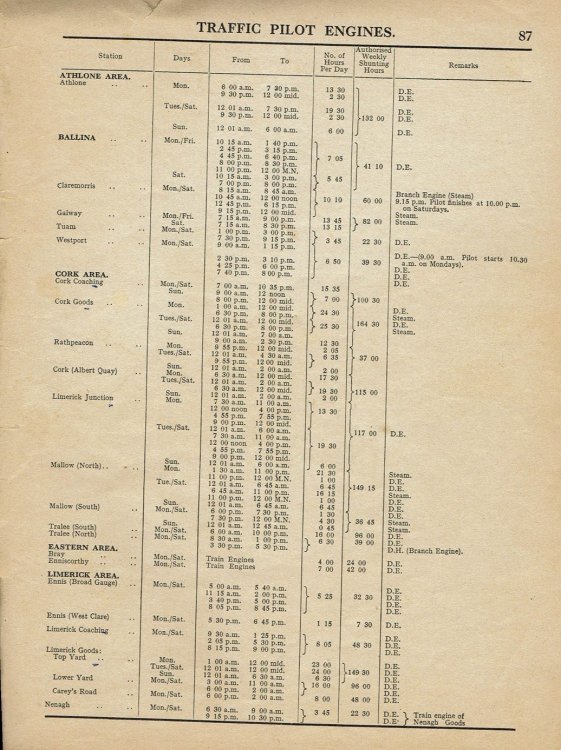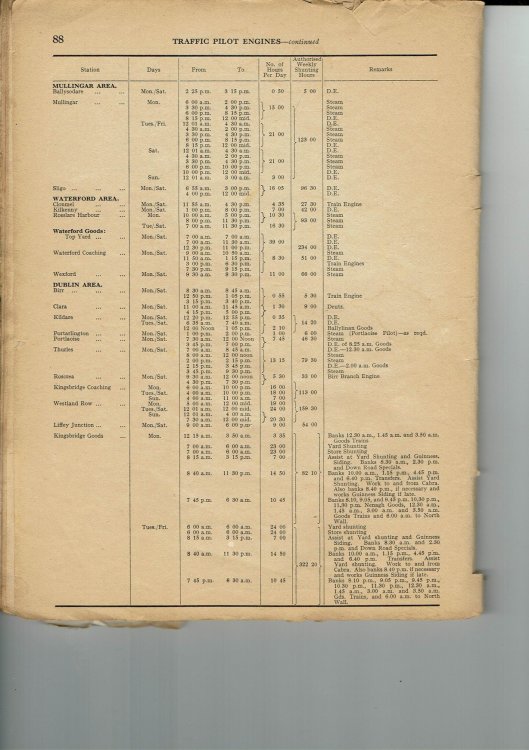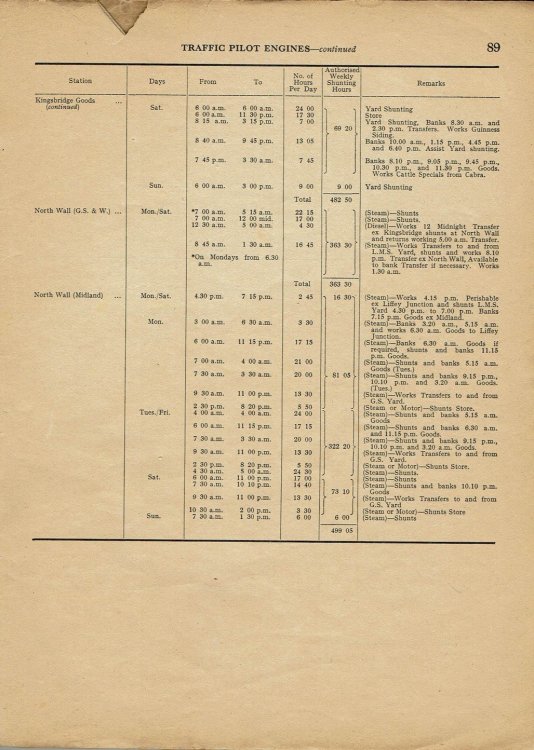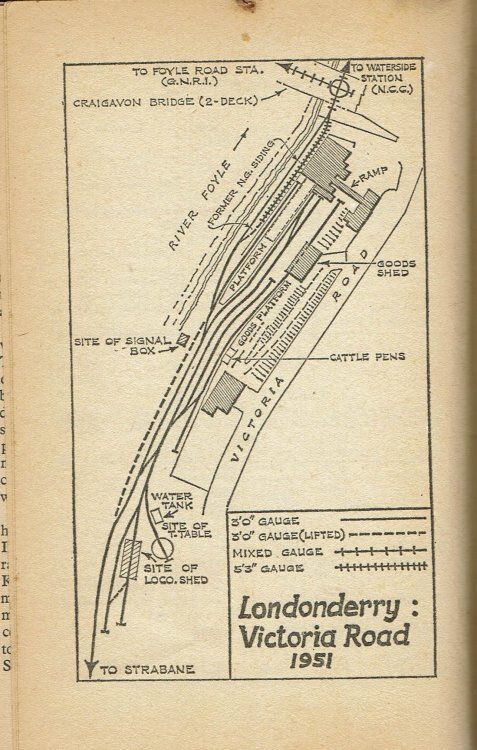-
Posts
4,899 -
Joined
-
Last visited
-
Days Won
119
Content Type
Profiles
Forums
Events
Gallery
Blogs
Community Map
Everything posted by Mayner
-
Its possible that the Newcastle Van may have been used to carry mails or parcel traffic. It looks suspiciously like a conversion of a standard GSWR 10T outside brake. It looks like there is a set of side doors in the luggage compartment, as the "door" panel appears to be proud of the main body framing and planking. The LSWR vans appear to have been set up with separate guards and goods compartments with a connecting doorway. Some of the LSWR road vans had single others had two balconies The GNR(I) built a pair of 25t 6 brakes with "Luggage Compartments" for the steeply graded Newry-Armagh and Keady lines.
-
One end converted to a van possibly for sundries traffic on a light traffic branch line. Purpose built "road vans" were used by the West Cork, NCC, SLNCR & T&C in Ireland and the LSWR in England, though they tended to look like a conventional goods van with a veranda or guards compartment at one end. Interestingly the guards steps and grab rails appear to have been removed from the "van" end of the converted ex-GSWR brake. Traditionally MGWR goods brakes included a drovers compartment and a cupola in the style of an American drovers caboose.
-
I imagine a repeat would depend on demand reaching or exceeding Kader's/Bachmann minimum quantity for a production run. Kader's minimum production run may be a lot higher than the factories that supply commissioners like IRM, Kernow and Hattons, as they tend to have focused in recent years on high volume production for the mainstream end of the American and UK market. While Murphy Models are likely to own the IP for the drawings & information supplied to Bachmann UK/Kader. Kader are likely to own the IP to the tooling as it is their design and are unlikely to agree to releasing the tooling to competitor to produce a small run of models. Kader retained the IP for models produced for Palitoy and Replica Railways iin the 70s & 80s which formed the core of the Bachmann Branchlines range in the 1990s. Some OEM models produced by Kader for commissioners like the E-R Models Baldwin Sharknose N & HO scale diesel have re-appeared in the Bachmann range when the original commissioner folded.
-
I love the snow scenes and the photos of the railway in operation, the approach to the station with the dense vegetation and bracket signal reminds me of Rathdrum. Building and maintaining a garden railway is a major challenge though very satisfying and I manage to run trains through most of the year. I find Autumn particularly challenging with leaf clearing a major weekly operation as there are large deciduous trees in our garden and and on our street.
-
Australian supermarket owner tells customer what to do with 5000 rolls of toilet paper and 150 packs of hand sanitiser after he asked for a refund Customer asked for a refund when e-bay refused to list the toilet rolls and hand sanitiser. I wonder did he pay the 20 people he got to do the shopping? https://www.nzherald.co.nz/world/news/article.cfm?c_id=2&objectid=12324944&&ref=recommended Our supermarkets restricted customers to two packs of packaged items each, only thing that has run out is flour with a lot more home cooking.
-
I think its likely to be later than 76, I think the Uniload containers for sundries traffic and Bedford TKs with tail lifts were introduced (on the Sligo & Wexford lines a year or two later. Luggage Van could be 2549-2558 Series 1960 or one of the later conversions from GSR Bredin coaches 2559-61----1971 or 2562-2591----1973 parcel traffic was serious business those days. I remember seeing an on line photo of the Athlone-Westport Night Mail at Roscommon made up of a 141 Class hauling a single luggage van, with a Renault R4 van picking up the mails, priceless if I could find it!
-
The Hornby Fowler 2-6-4T https://www.hattons.co.uk/10010/hornby_r2398_class_4p_2_6_4_42322_fowler_tank_in_br_black/stockdetail.aspx is pretty much the standard rtr donor for WT/jeep conversions. There are articles on Jeep conversions in the New Irish Lines Archive https://newirishlines.org/archive/. Colm Flannigan May 2004 & Nov 2006 editions. Richards Hobbs May 2017 edition. An etched body only kit designed to fit the Hornby chassis is available from Worsley Works, the kit does not include turned parts or castings and is only really suitable for modellers experienced in kit or scratchbuilding in metal.
-
Getting to see the light at the end of the tunnel, tender brake gear and final detailing. Another simple assembly jig to achieve some form of consistency in fitting the brake shoes to the hangers. Short piece of 0.45 wire drilled into block to pin shoe to hanger. One piece of 0.7mm to hold hanger in alignment & 2 short pieces of 0.7 to hold shoe in correct position while soldering. 3 sets of brake shoes and hangers and pull rods awaiting assembly. The pull rods were drilled 0.5mm before being removed from the fret. Assembled chassis. Although the kit is designed to use the SSM tender, I designed a new tender chassis to simplify weight transfer from the tender to the loco and beefed up the tender pull rods slightly to simplify assembly. The brake gear supplied with the SSM J15 is very fine and had experienced difficulty in assembling the brake gear on a loco several years ago. Assembling the kit to 21mm gauge with EMF profile wheels I was able to incorporate the distinctive double pull rod arrangement. Its best to omit the inner pull rods and fit the outer set to the tender body if you work in OO or use RP110 profile wheels. The brake gear is designed to be removable for painting and maintenance, with the hangers a push fit at the top with the bottom stretcher bar retaining the gear in position. Tender sub assemblies, the tender springs will be fitted after I have painted the tender. I drilled on spring 0.5mm as a template for drilling holes in the side of the tender, then use the original as a template for drilling the other springs, 0.45mm pins and axleboxes are retained with 100° low melting point solder. The large holes in the frame spacers arose as a result of an error in the tender CAD work. I went mad and modelled the tender brake shaft and linkages to the pull rods, barely visible in 4mm unless the loco and tender are uncoupled. LHS tender handrail and handbrake wheel to be straightened up. Tender tool boxes are from lost wax castings from a 3D printed original. Cab interior with splashers and reversing wheel fitted, cab floor and backhead to be tidied up when I complete mechanical installation. Valence and steps on fireman's side needs straightening. Posed portrait. Fairing between training bogie wheel and leading driver to be fabricated. Crankpins will be trimmed flush with nuts as part of final mechanical assembly
- 396 replies
-
- 10
-

-

-
Alkaline rather than acid basically a very large Nickel Zinc battery similar in principal to today's NiMH batteries https://en.wikipedia.org/wiki/Nickel–zinc_battery
-
Jeremy Clements wrote about his experiences in maintaining the locos and stock on the O Gauge Malahide Castle layout in the May 2011 edition of New Irish Lines https://www.dropbox.com/s/4xsw7iaya1qchkr/New Irish Lines - Vol. 6 No. 1 - 2011 May.pdf. It will be interesting to see how contemporary rtr locos and stock perform in similar conditions. The major risk is that replacements for parts that wear out like pick ups, transmission parts, motors and wheel sets are unlikely to be available once the manufacturers stock of spares from the initial production run sells out.
-

Cuisle na Tíre (“Ireland’s Transport Magazine”)
Mayner replied to jhb171achill's topic in General Chat
The most touching feature is the respect the magazine shows that the company still understood and valued the contribution of the individual who carry out humble but critical roles, it would be difficult to imagine a modern day public transport operator doing a similar feature on its staff in a public magazine. -
Here here! I just found out today that a very close relative in Ireland ended up in intensive care after he and his wife caught the dreaded virus, fortunately they both safely made it home.
-
I am inclined to agree with Edo that the photo is of an up train leaving Longford for Mullingar or Broadstone. The position and profiles of the loco shed, carriage shed and signal cabin were unique to Longford, "the churchspire" or blemish is likely to be the post of the down home signal. Longford engine shed had a high almost Spanish mission style cupola smoke vent, a carriage shed existed between the loco shed and down platform into GSR days which with the MGWR style footbridge would have created a twin arch effect. The train consist appears to have been fairly typical of Sligo line trains in GSR days with coaches followed by a string of non-passenger coaching stock possibly Meat or Fish Vans rather than horseboxes.
-
Having finished Aurora and 650 I though it was time to finally finish the test build of 52 Class GSWR No 1 starting with the loco brake assembly. 1st job was to drill out the pin holes 0.7mm for the brake hangers and 0.5mm for the brake shoes, despite the pin chucks struggled to grip an 0.5mm bit despite using the smallest size of collet, pin holders, I eventually used a thin slip of paper as a shim to secure the bit! The GSWR used an unusual double hanger arrangement on the 52 Class which was a bit of a challenge to design, Brake hangers as removed from fret on left, spacing washers folded over and brake shoe removed from hanger on right. Assembly jig using 0.7mm wire drilled through hanger into hardwood block, small drop of oil on wires to prevent soldering wires to hangers during assembly. Hole for 0.45mm wire for securing brake hanger drilled into hardwood block (do not oil wire!) brake shoe and second brake hanger threaded into position. Brake shoe soldered to hangers once correctly positioned and surplus o.45 wire trimmed off. I then removed one of the 0.7mm pins in turn before soldering the ends of the two brake hangers together, then cleared out the hole with a 0.7mm drill or a tapered broach. The brake stretcher bars and pull rods fitted together without a problem, there is sufficient space below the gear wheel when using a High Level Gearbox to bring the ends of the pull rod together below the brake cylinder position. I have not soldered the hangers to the top pivot wires as I prefer to assemble the brale gear as a separate sub assembly to allow the wheels and motor to be removed for maintenance or painting. I accidentally sent a superseded drawing to engraver which omitted the fairing that hides the leading sandbox and fills most of the space between the trailing bogie wheel and leading driver, I will form this part in the traditional way with a piercing saw and files of the test build. Despite a few anxious moments the loco brake gear fitted together without any problems, next stage is to assemble the tender brake gear and add complete detailing of the loco and tender before completing mechanical assembly.
- 396 replies
-
- 10
-

-

-
650 was No 13 Racer 655 was no 29 Clonsilla
-
My main workshop/railway room is in a converted 90 odd year old garage no doubt intended for the owners Model T or Bullnose Morris when our neighbourhood was first established. Although the timber framing and weatherboard was in good condition the building was leaning at an angle when we first moved in as the original foundation piles had rotted away. Several years later having leveled up and re-piled the building, lined and decorated the interior the conversion to a railway room is very much a work in progress, so far this year we have moved out most of my building and woodworking tools to a new workshop and I am planning to replace the existing roller shutter door with something more in keeping with the age and character of the building. Main work area with spray booth/paint shop in foreground and workbench in background. Large scale Loco roster/blackboard. I will remove the scroll saw to the general workshop eliminating the final source of wood dust from the railway workshop. The opposite aisle with the exhaust for the spray booth, traverser for future Irish layout on right. Main modelling workbench, modelling is done on an offcut of kitchen bench top in center, collection of soldering irons in foreground, Unimat set up as vertical drill in distance. Workbench has to be large enough for working on 1:20.3 scale locos & stock and assembling large scale track panels. Yellow storage bins mainly contain 4mm detail castings, & kit scratchbuilding parts. Looking toward the open doorway, jungle taking over outside! My version of the waiting/scrap lines at Inchacore works, the J15s are due to return to the works once I have completed three current projects. 9mm scale NZR loco in background. Opposite side of aisle to main work bench, large scale staging/fiddle yard on lowest level, live steam loco and N gauge layout sitting on baseboard for 4mm layout even more storage above!
-
Traffic Pilot Section from CIE 1960 WTT. At that stage the majority of Pilot Locos were diesel electric most likely C Class with limited use of steam most likely Southern or Midland Standard goods or ex-GNR goods locos in the Dublin area. A steam loco was scheduled as Galway Station Pilot 7:15am -9:00pm Mon-Fri. 7:15am-8:30 Sat Sligo Pilot DE 16 hrs daily 5:55am-12:00 Midnight Mon-Sat with a 1hr break 3-4 pm possibly for a crew change. Ballysodare was allocated a DE pilot loco for 50 minutes daily Mon-Sat 2:25-3:15 to allow the loco of the 03:40 Mullingar-Sligo goods to shunt Pollexfen's Mill sidings.
-
Yep knew it was Sid Vicious but some how or other came up with Johnny Rotten, woke up yesterday with "My My Hey Hey Out of the Blue" running through my head----------got a lot of work done though!!!!!!!!!!!!. To a degree I moved back to Irish modelling I moved back to Irish modelling about 20 years ago, when British outline modelling lost its challenge with the explosion of rtr with Bachmann entering the British market and Hornby shifting production to China. I used to enjoy assembling British outline steam locos from DJH & Comet kits taking 6 months to a year to complete each loco only problem was someone would announce or bring out a rtr version shortly after completing the model, much less of a risk with Irish steam era modelling.
-
A short section of double track was retained on the approaches to Sligo when the Ballysodare-Sligo section was singled following the closure of the SLNCR. The signals and point controlling access to the double track section was power operated from Sligo Cabin. During/following the Civil War the GSWR/GSR developed a system to control junctions remotely using hand generated electricity, the installation was first trailed at Cherryville Junction and later installed to replace signal cabins at branch line junctions including the junctions with the Banagher, Cavan & Macroom branch lines. The control equipment was moved around as junctions were closed or converted to manual operation, Sligo may have received the equipment that controlled the junction with the Banagher branch when the branch was converted to 'One Engine' operation in the late 1950s, Collonney Junction may have received the equipment from Inny Junction following the closure of the Cavan branch in 1963. The train engine performed the run round operation at Sligo at least from the 1970s up to the re-signalling of the station in the early 2000, propelling the train out of the Arrival Platform running round via the points just past the Maugheraboy Road overbridge and propelling back into the Departure Road. The run round of intercity trains was performed in a similar manner at Galway. While there may not have been a loco specifically allocated for shunting or pilot duties at Sligo during the "Supertrain" Era, the train engine of the Night Mail or goods train may have been available for carriage shunting at the station during the trains lay-over. Night Mail Trains operated to both Galway and Sligo up to the early 1990s which would have involved an element of carriage shunting at the station, the Galway Night Mail in its final years ran as a Mail Goods effectively a mixed train with coaching and wagons stock. The older CIE working timetables include a schedule of Pilot Duties for the entire rail system, in some cases the duties were undertaken by a train engine e.g. Nenagh where the loco of the Dublin-Limerick goods was allocated several hours to shunt the yard before continuing to its destination.
-
I wonder if its somewhere on the Midland rather than Harcourt Street. It doesn't look like Broadstone as the line entered a deep cutting before passing under the North Circular Road The make up of the train is pure Midland with an ex MGWR Cs GSR 536 or 540 Class leading and a long string of passenger rated vans behind the second coach, typical of Sligo & Mayo trains. The buildings at Harcourt Street appear to be on a much smaller scale than those in the background, the area on either side of the train appears very rural for the raised section of railway between Adelaide Road and the Grand Canal, the line on the left appears to be a siding rather than a running road. https://irishphotoarchive.photoshelter.com/image/I0000kXkNdsSJDXI.
-
I ended up taking a one way trip to New Zealand but that's another story. IRM , Accurascale focus on selling wagons that will sell in high volumes like block train wagons, where individual customers are likely to want a complete train of the same or similar wagons rather than items like goods brake vans where a customer or collector is likely to only buy one or two of a particular item. If someone believes that their is sufficient demand (2-3000 minimum) for a particular model there is nothing to stop them from commissioning a model direct from a manufacturer or launching a crowdfunding appeal https://www.indiegogo.com/projects/ho-40-single-sheathed-box-and-auto-cars-1929-70s#/. How we intend to spend our modelling/leisure time whether its running rtr trains, building models or simply collecting kits and models is one of life's most important decisions, whatever an individual decides is equally valid and should be respected. While rtr has to a degree decimated kit and component manufacturing, from looking a scratch & kit building threads on IRM, RM Web and other on line groups and on line auction results there is still considerable interest in scratch and kit building, one of the more encouraging things is the interest in scratchbuilding & enthusiasm show by younger modellers entering the hobby like Nelson Jackson and Midland Man. I started out scratchbuilding in the 70s out of pure necessity as much as my interest in the oddball and the obscure as I could not afford to buy rtr Hornby or British Trix models on my pocket money as a teenager or wages while serving my apprenticeship. It took many years to develop my skills to build a half decent model form scratch or a kit (I scrapped or ended up re-working most of my early stuff) and although I got side tracked in many directions I would have not done it any other way. (Not sure whether I am starting to sound like Sinatra or Johnny Rotten singing "I did it my Way" though I would identify more with Johnny Rotten
-
You have hit the jackpot with that one JHB, 64 (427) was one of 6 LNWR Web 4'6" radial tanks purchased by the DWWR for £1500 in 1902 This is what 427 looked like before the Dublin Wicklow and Wexford got their hands on it, and probably explains why the locomotive was not returned to Great Britain with the other 5 members of her class during WW. The DSER rebuilt 64 Earl of Bessborough (427) with a new boiler and cylinders in 1914, resembling a DSER 2-4-2T above the running board with large diameter high pitched boiler & DSER style cab, the smaller 4'6" diameter driving wheels are the main give away to its LNWR origin. https://en.wikipedia.org/wiki/LNWR_4ft_6in_Tank_Class
-
The 1951 diagram in Patterson's book "The County Donegal Railways" indicates that the signal cabin was located beside the river as in the above photo. There does not appear to have been enough space between the running lines to locate the cabin at the end of the platform. Foyle Road would make a very nice model for a compact city terminus standard or narrow gauge. Goods traffic in later years mainly appears to have been fuel oil for the Killybegs Fishing fleet, there are several photos of short cuts (2-3) on narrow gauge tank wagons at Foyle Road and in mixed trains on the Foyle Road-Strabane line. The tank wagons presumably have come across the Harbour Commissioners Tramway and the Foyle Bridge, the Lough Swilly also had a small fleet of tank wagons.
-
I have managed to spread myself around with a home office/model railway room in the house and a converted garage in the garden. The office is the nerve center, library and archive, home for my Irish narrow gauge layout Keadue and lots an lots of junk and clutter. We have high ceilings in our house which gives us a lot of vertical storage. Desk where I do most of my CAD work, roadside section of layout and fiddle yard above. Original modelling workbench on right, storage bins below, Keadue station above. The shelf above the layout is due to be converted to a bookshelf. I am planning to install a lighting pelmet above Keadue to frame the layout better and to reduce dust fallout. The workbench (self assembly kit) was one of the first things in we bought after we arrived in New Zealand looks nice but not very practical. I started the layout shortly after we bought the bench in 2004 and its still incomplete! The other side of the room! The bottom L shaped shelf is due to be cleared for an N Gauge layout, the storage boxes in the center of the room are due to be re-located to the wife's new studio/office in the garden.
-
There is a totally different account of Cs (D6 & D7) performance by Jack O'Neill and Drew Donaldson in a "Decade Of Steam in the Fifties" an RPSI paperback published in the early 70s, where they are described as free steaming but rough riding engines. Jack O'Neill describes firing 540 on the Up Galway mail from Mullingar to Dublin and calls them "fine mainline steeds". Drew describes D6 543 'doing well" with the Claddagh Express in 1953 (a forerunner of the Cu-na-Mara diesel trains) exceeding 70 down Woodlawn bank and knocking 3 minutes off the schedule between Ballinasloe & Athlone with a max of 67½mph and similar exploits with 538 on an up Sligo Night Mail in 1950 and 536 on a Limerick-Dublin train (via Nenagh) in 1939. The poor performing assessment of Midland 4-4-0s appears to have been made by Inchacore engineering staff who were familiar with GSWR loco practice and distrustful of the works of Broadstone, following the introduction of the AEC railcars there was very little work for large 4-4-0s on the Midland system, the majority of Midland and GSWR large 4-4-0s were withdrawn within the same timeframe (1953-1959). Personally the odd thing is that nothing appears to have been done to reduce their rough riding, though the Woolwich Moguls had a similar reputation.
.png.c363cdf5c3fb7955cd92a55eb6dbbae0.png)

